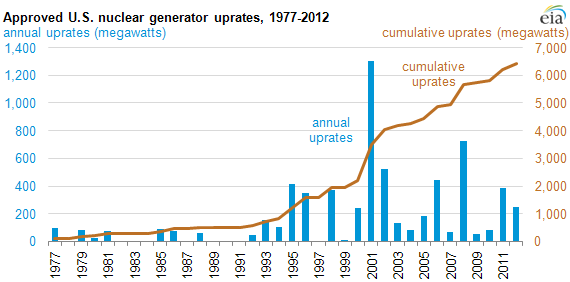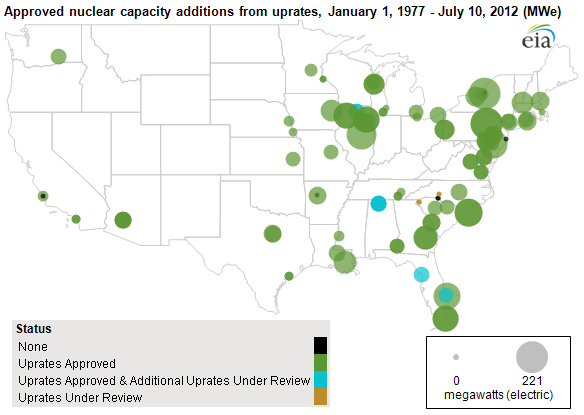
Uprates can increase U.S. nuclear capacity substantially without building new reactors

Currently, there are 104 commercial nuclear reactors in the United States. In 2011, these plants provided 786 billion kilowatthours of electricity, or nearly one-fifth of total generation. The electrical output of the nuclear power plant fleet can be increased either by constructing new plants or by 'uprating' operating plants. Uprating generally involves physically modifying the plant to increase its generating capacity. Since 1977, more than 6,500 megawatts-electric (MWe) of nuclear uprates have been approved, and most of these have already been implemented. Through July 10, 2012, these cumulative uprates are roughly the equivalent of constructing six new nuclear power plants.
The Nuclear Regulatory Commission (NRC) reviews uprate requests from a nuclear utilities to assure the continued safe operation of these plants; uprates may not be implemented without NRC approval. Since the first requests in 1977, the NRC has approved 144 uprates. Uprates are categorized based on the magnitude of the increase in electrical output as well as the manner in which the increase is achieved. There are three types of uprates:
- Measurement uncertainty recapture (MUR) uprates generally result in an increase in electrical output of less than 2% and involve implementing enhanced methodologies for calculating reactor power and/or replacing old analog instrument sensors and control systems with modern sensors and digital control systems. These are typically low-cost uprates. To date, the NRC has approved 55 MUR uprates, totaling about 829 MWe. The first MUR uprate was approved for Comanche Peak Unit 2 (near Fort Worth, Texas) in 1999. The smallest MUR uprate, also for Comanche Peak, totaled 4 MWe in 2001.
- Stretch uprates increase electrical output by 3% to 7% and generally do not involve major plant modifications. Older components may be replaced with newer designs and modern materials. These are typically moderate-cost uprates. To date, the NRC has approved 65 stretch uprates, totaling about 2,832 MWe. The first stretch uprates were approved for Calvert Cliff Units 1 and 2 (in Lusby, Maryland) in September 1977.
- Extended uprates increase electrical output by more than 7% and can be as large as 20%. Extended uprates generally involve significant plant modifications and may take years to fully implement. To date, the NRC has approved 26 extended uprates, totaling about 2,883 MWe. The first extended uprate was approved for Monticello (near Minneapolis, Minnesota) in March 1998. The largest extended uprate of 193 MWe was approved for the Clinton Unit 1 (near Bloomington, Illinois) in 2001.
Uprates may be implemented incrementally or in combination with each other. The new capacity from nuclear uprates can be put into place quickly, as compared to new plant construction, and only as needed by actual demand growth. Although not restricted by NRC regulations, the total uprate potential of any reactor generally will not exceed 20% of the original licensed capacity of the reactor.
All but six of the 104 U.S. reactors have applied for an uprate, and only one reactor, Vermont Yankee (near Brattleboro, Vermont), applied and was approved for a full 20% extended uprate. Susquehanna Units 1 and 2 (near Berwick, Pennsylvania) and Edwin I. Hatch Units 1 and 2 (near Vidalia, Georgia) are the only reactors to have received NRC approval for all three types of uprates.
Currently, the NRC is reviewing applications for seven extended and nine measurement uncertainty recapture (MUR) uprates. If approved, these uprates would add about 1,140 MWe of nuclear capacity, in addition to the approximately 6,500 MWe already approved by the NRC. The total 7,640 MWe is roughly the equivalent of seven reactors the size of each of the Vogtle Units 3 and 4 reactors, which just received their combined construction and operation licenses in February 2012.
The map below shows the status of approved and pending uprates as well as the locations of nuclear power generators that have not yet submitted an application for an uprate.

Note: Bubble size represents only the amount of approved nuclear capacity additions.
Tags: capacity, electricity, map, nuclear, power plants, states